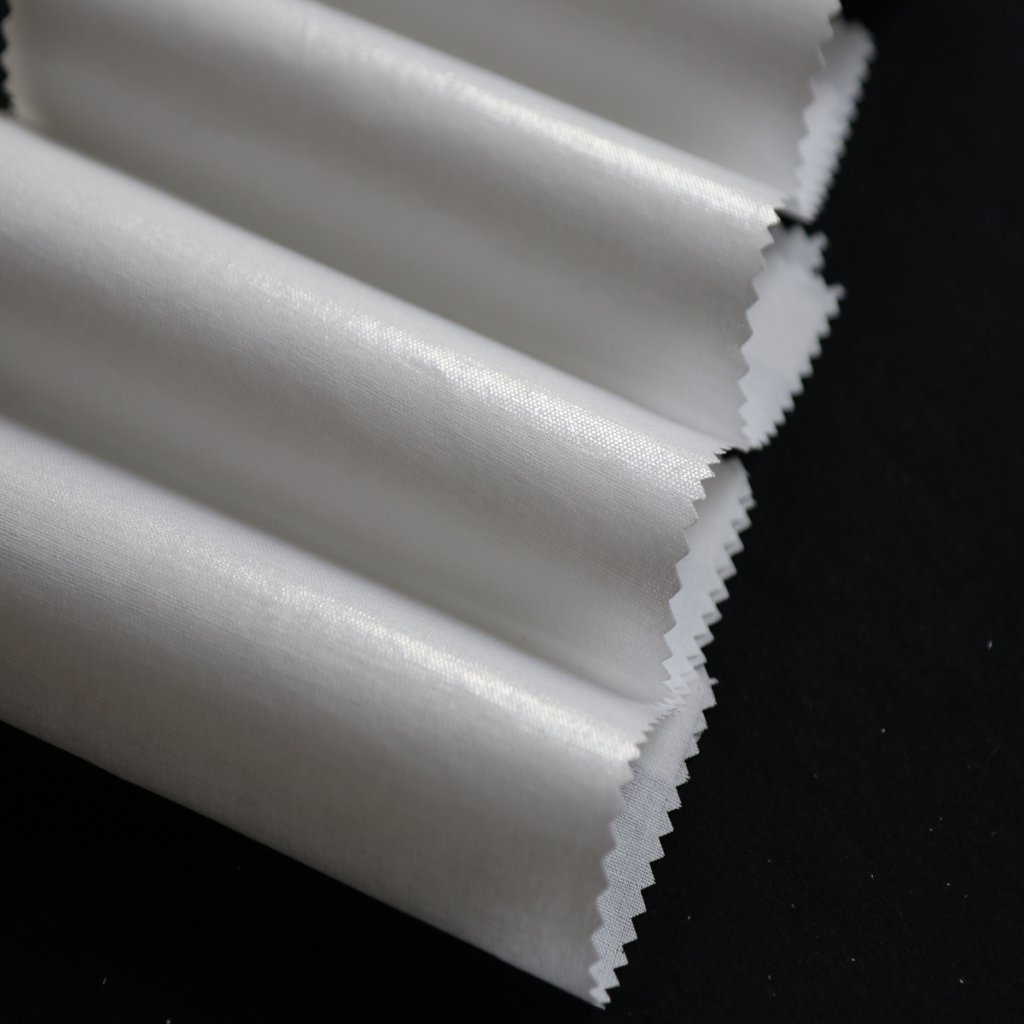Introduction
Have you ever wondered what goes into the construction of a well-made shirt? One key element that often goes unnoticed but plays a significant role is interlining. Interlining refers to a layer of fabric or material inserted between the main fabric and lining of a shirt, and it serves various purposes in enhancing its structure, shape, and durability.
But did you know that different types of interlining are available, each with unique characteristics and applications? This blog post will explore the world of interlining and delve into the different types. So, let’s unravel the mystery and discover the various interlining options for shirts that can take your garment to the next level of quality and style.

Interlining for Shirts: Fusible Interlining
Fusible interlining is a popular type of interlining widely used in shirt construction. It is characterized by its adhesive coating on one side, which bonds to the fabric when heat and pressure are applied. This adhesive layer is made of a thermoplastic material that melts upon heating, creating a strong bond between the interlining and the fabric.
Fusible interlining works by fusing the interlining to the fabric, providing stability, shape, and reinforcement to specific shirt areas. It is commonly used for collars, cuffs, plackets, and other areas that require structure and support. The application involves placing the interlining on the fabric, covering it with a pressing cloth, and using an iron to activate the adhesive and create a bond.
Using fusible interlining offers several advantages. Firstly, it is relatively easy and quick to apply, making it a convenient option for professional shirtmakers and DIY enthusiasts. Additionally, it provides excellent stability and shape retention, ensuring that collars and cuffs maintain their crisp appearance even after multiple washes. Fusible interlining also adds a layer of durability, making the shirt more resistant to wear and tear.
However, fusible interlining does have some disadvantages to consider. Over time, the adhesive may deteriorate, causing the interlining to detach or bubble. This is especially true if the shirt is subjected to harsh washing or ironing. Furthermore, fusible interlining is not suitable for all fabrics. Delicate or heat-sensitive materials may be damaged by the heat required for fusing.
Fusible interlining is most suitable for medium-weight to heavyweight fabrics, such as cotton, linen, and some blends. It is commonly used in dress shirts, blouses, and formalwear where a structured appearance is desired. Fusible interlining can significantly enhance a shirt’s overall quality and aesthetic by choosing the appropriate fabric and application technique.
Interlining for Shirts: Sew-In Interlining
Sew-in interlining, also known as sew-in interfacing, is an interlining stitched into place rather than fused with heat. It is typically made of lightweight to medium-weight fabric or non-woven material, providing stability and reinforcement to specific shirt areas.
Applying sew-in interlining is cut to match the desired shape and size and then sewn directly onto the fabric. This can be done using a regular sewing machine or by hand, depending on the complexity of the garment and the interlining placement.
It is particularly suitable for delicate fabrics that may be damaged by heat. However, sew-in interlining does have a few drawbacks. It can be more time-consuming and labor-intensive than fusible interlining; sew-in interlining suits a wide range of fabrics, including lightweight cotton, silk, and synthetic blends.
Interlining for Shirts: Knit Interlining
Knit interlining is a unique type that stands out from other options due to its construction and characteristics. Unlike woven, knit interlinings are made from knitted fabrics, providing stretchability and flexibility. This makes them an ideal choice for garments that require freedom of movement, such as shirts.
Compared to other types of interlining, knit interlining offers several advantages. Firstly, its stretchability allows for better comfort and ease of wear, as it moves with the body without restricting movement. Knit interlining also provides a softer and more pliable feel, resulting in a more natural drape and appearance. Additionally, it is less prone to wrinkling, making it easier to maintain the garment’s crispness.
However, knit interlining does have some drawbacks to consider. It may provide less structure and stiffness than other types, which may disadvantage certain shirt styles that require a more rigid collar or cuffs. Knit interlining is most suitable for fabrics with a degree of stretch, such as cotton blends, stretch poplin, or knitted fabrics.

Canvas Interlining
Canvas interlining is a type of interlining that is known for its sturdy and rigid nature. It is made from woven cotton or linen fibers and has a dense, closely-knit structure. This gives it excellent shape retention and durability, making it ideal for enhancing the structure of shirt collars and cuffs.
Using canvas interlining for shirt collars and cuffs is usually cut to match the shape and size of the collar or cuff pattern piece. It is then basted or sewn onto the wrong side of the fabric before the collar or cuff is assembled. The canvas interlining provides a firm foundation, giving the collar or cuff a crisp and structured appearance.
One of the primary advantages of canvas interlining is its ability to maintain the desired shape and form over time. It adds strength and stiffness to the collar and cuffs, preventing them from sagging or losing shape.
However, the rigid nature of canvas interlining can also be considered a disadvantage in certain situations. It may not be suitable for shirts that require a softer or more relaxed collar and cuff.
Canvas interlining is commonly used with heavier fabrics such as twill, oxford cloth, or flannel.
Interlining for Shirts: Non-Woven Interlining
Non-woven interlining is a type of interlining that is created by bonding fibers together using heat, pressure, or adhesives rather than weaving or knitting. It is characterized by its soft and flexible nature, making it ideal for adding lightweight support and comfort to shirts.
Non-woven interlining is manufactured by layering and bonding fibers through needle punching, thermal bonding, or chemical bonding. This creates a web-like structure with intertwined fibers that provide stability and reinforcement to the fabric.
Using non-woven interlining offers several advantages. Firstly, it is lightweight and breathable, ensuring the shirt remains comfortable. It also provides a subtle level of support and shape without adding bulk.
However, It may provide less structure or durability than other types, making it more suitable for lightweight or casual shirts rather than formal or structured garments.
It is ideal for applications such as shirt collars, cuffs, and plackets, where a subtle level of reinforcement is desired without compromising comfort.
Interlining for Shirts: Selecting the Right Interlining
Choosing the appropriate interlining for shirts is crucial to achieving the desired outcome regarding structure, appearance, and performance. Several factors should be considered when making this decision.
When selecting interlining, it is essential to consider the fabric weight and structure. Different interlining types work better with specific fabric weights and weaves. For lightweight fabrics, such as silk or chiffon, a lightweight and flexible interlining, like non-woven or knit interlining, may be more suitable. Heavier fabrics, like denim or wool, may require sturdier options such as fusible or canvas interlining to provide sufficient support.
Analyzing the desired shirt characteristics and style is another important consideration. Fusible interlining can achieve sharp collars and cuffs for a crisp and formal appearance. For a more relaxed and casual look, non-woven or knit interlining can offer a softer and more flexible structure. The interlining choice should align with the shirt’s overall style and aesthetic goals.
Matching the interlining type to the shirt’s intended use is crucial for optimal performance. Shirts designed for everyday wear may benefit from durable and long-lasting interlining like canvas interlining. On the other hand, shirts intended for special occasions may require a lighter and more delicate interlining that provides comfort without compromising style.
Care and Maintenance of Interlining for Shirts
Proper care and maintenance are essential to preserve the quality and longevity of interlined shirts. Here are some guidelines to ensure your shirts retain their structure and appearance over time:
When washing interlined shirts, following the care instructions provided by the garment manufacturer is advisable. However, as a general rule, using a gentle or delicate cycle with cool or lukewarm water is recommended. Avoid harsh detergents or bleach, which can weaken the interlining or cause discoloration.
When drying interlined shirts, air drying is preferable to machine drying. Hang the shirt on a hanger or lay it flat on a clean surface to dry naturally. Excessive heat from tumble drying can cause the interlining to shrink or lose its shape.
When ironing interlined shirts, use a moderate temperature setting. Place a pressing cloth or a thin fabric layer between the iron and the shirt to protect the interlining. Avoid excessive steam, as it can loosen the adhesive in fusible interlining. For sew-in interlining, press gently to avoid distorting the shape.
Handle interlined shirts with care to prevent unnecessary stress on the interlining. Avoid pulling or stretching the fabric excessively, especially around collars and cuffs. Hang the shirts on sturdy hangers to maintain their shape and avoid creasing.
If you notice any issues with the interlining, such as bubbling or detachment, consider having it repaired by a professional or replacing the interlining if necessary.

Interlining for Shirts: Conclusion
We have explored the various types of interlining for shirt construction. We discussed fusible interlining, sew-in interlining, knit interlining, canvas interlining, and non-woven interlining, each with unique characteristics and applications.
Appropriate interlining is crucial for achieving a shirt’s desired structure, shape, and durability. When choosing the interlining type, it is important to consider factors such as fabric weight, intended use, and desired aesthetic.
Additionally, we encourage you to experiment and explore different interlining options to create unique shirt designs. Understanding the different interlining types and benefits can elevate your shirtmaking skills and create visually appealing and long-lasting garments.

